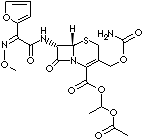| CAS
NO. |
64544-07-6 |

|
| EINECS NO. |
|
| FORMULA |
C20H22N4O10S |
| MOL
WT. |
510.47 |
|
H.S.
CODE
|
|
|
TOXICITY
|
|
| SYNONYMS |
Cefuroxime 1-acetoxyethyl ester; |
| (6R-(6alpha,7beta(Z)))-3-(((aminocarbonyl)oxy)methyl)-7-((2-furanyl(methoxyimino)
acetyl) -amino)-8-oxo- 5-thia-1-azabicyclo[4.2.0]oct-2-ene-2-carboxylic acid, 1-(acetyloxy)ethyl ester; Ceftin; Cefurax;
Cefuroxine 1-acetoxyethyl ester; |
|
CLASSIFICATION
|
ANTIBOITICS
/ CEPHALOSPORINS
/
|
|
PHYSICAL AND CHEMICAL PROPERTIES
|
| PHYSICAL
STATE |
White to off-white powder |
| MELTING POINT |
|
| BOILING
POINT |
|
| SPECIFIC GRAVITY |
|
| SOLUBILITY
IN WATER |
|
| pH |
|
| VAPOR DENSITY |
|
|
AUTOIGNITION
|
|
|
NFPA
RATINGS
|
|
|
REFRACTIVE
INDEX
|
|
| FLASH
POINT |
|
| STABILITY |
Stable
under ordinary conditions. |
|
GENERAL
DESCRIPTION & APPLICATIONS
|
|
Cephalosporin: any of a group of broad-spectrum derived from species of fungi of
the genus Cephalosporium and are related to the penicillins in both structure
and mode of action but relatively penicillinase-resistant antibiotics. These
antibiotics have low toxicity for the host, considering their broad
antibacterial spectrum. They have the active nucleus of beta-lactam ring which
results in a variety of antibacterial and pharmacologic characteristics when
modified mainly by substitution at 3 and 7 positions. Their antibacterial activities
result from the inhibition of mucopeptide synthesis in the cell wall. They are
widely used to treat gonorrhea, meningitis, pneumococcal, staphylococcal and
streptococcal infections. The cephalosporin class of antibiotics is usually
divided into generations by their antimicrobial properties. Three generations of
cephalosporins are recognized and the fourth has been grouped. Each newer
generation of cephalosporins has broader range of activity against gram-negative
organisms but a narrower range of activity against gram-positive organisms than
the preceding generation. The newer agents have much longer half-lives resulting
in the decrease of dosing frequency. Accordingly, the third-generation
cephalosporins can penetrate into tissues well, and thus antibiotic levels are
good in various body fluids. Second-generation cephalosporins have broader
spectrums of activity against gram negative coverage but less active against
gram-positive organisms than first-generation agents. This group includes
cefamandole (CAS RN 34444-01-4), cefaclor (53994-73-3), cefuroxime (55268-75-2),
cefonicid (61270-58-4), ceforanide (60925-61-3). Cefoxitin (35607-66-0) and
cefotetan (69712-56-7) which are effectively active against bacteroides fragilis
are also included in this group, although they are cephamycins actually. |
| SALES
SPECIFICATION |
|
APPEARANCE
|
White to off-white powder |
|
ASSAY |
Cefuroxime Axetil:
96.0 - 102.0%
Cefuroxime: 745 - 875 µg/mg |
|
WATER |
1.5%
max |
|
SULFATE
|
0.2%
max
|
|
SOLVENT
RESIDUE
|
1.0%
max
|
|
RELATED
SUBSTANCE
|
Cefuroxime: 0.5 %
max
Delta2-Cefuroxime Axetil:
1.5% max
Anti-Cefuroxime Axetil: 1.0 % max
Individual Impurity: 1.5 %
Impurity:
3.0% max |
|
HEAVY
METALS
|
20ppm
max
|
| TRANSPORTATION |
| PACKING |
5kgs
- 25kgs |
| HAZARD CLASS |
|
| UN
NO. |
|
| OTHER
INFORMATION |
|
Price:

|
